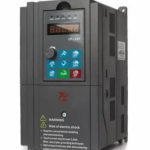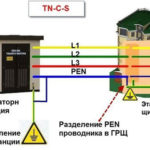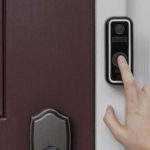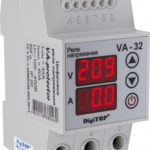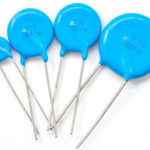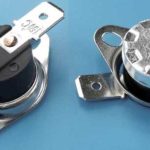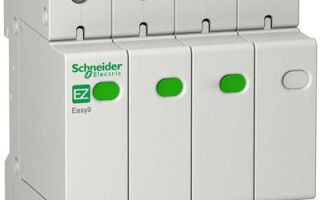Overvoltage is the exceeding of the maximum voltage for a particular network. A surge voltage refers to an abrupt jump in voltage between a phase and the ground, which takes a fraction of a second. Such a voltage drop is dangerous not only for the line, but also for the electrical appliances connected to it. To prevent this situation, a surge protector is used.
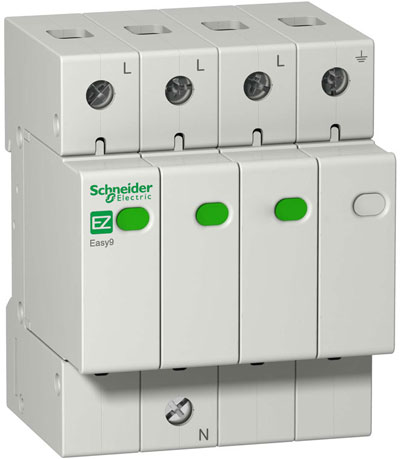
Contents
What is a surge protector and what does it do?
A surge protector is a surge protection device which protects electrical installations up to 1 kV. The device protects against overvoltages in the power grid as well as against lightning strikes by diverting current pulses to earth.
The surge protector is only used in low-voltage power distribution systems. This device is suitable for both industrial plants and residential buildings.
SPDs are of two types:
- OPS - mains surge suppressor;
- OIN - surge voltage limiter.
Operating principle and device
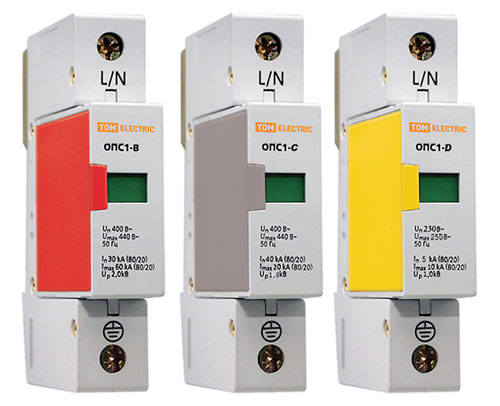
Operating principle of SPD is the use of varistors - a non-linear element in the form of a semiconductor resistor of resistance to the applied voltage.
The SPD has two types of protection:
- Unbalanced (in-phase) - when an overvoltage occurs, the device directs pulses to ground (phase to ground and neutral to ground);
- Symmetrical (differential) - when an overvoltage occurs, energy is sent to another active conductor (phase - phase or phase - neutral).
To better understand the principle of the surge protector, here is a small example.
The normal voltage of a circuit is 220 V, but when a pulse occurs in this very circuit, the voltage rises sharply, e.g. when lightning strikes. When a sudden voltage spikeThe surge in the surge protector decreases its resistance, resulting in a short circuit, which in turn triggers the circuit breaker and subsequently leads to disconnection of the circuit itself. Thus, the electrical equipment is protected from sudden changes in voltage, preventing the passage of high voltage pulses through it.
Types of surge protectors
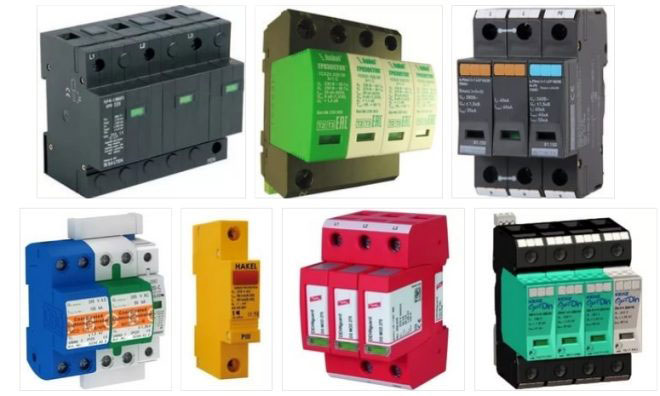
Surge voltage surge protectors come in single and dual input versions, and subdivided into:
- Switching;
- Limiting;
- Combined.
Switching surge protectors
A characteristic feature of switching devices is their high resistance, which drops instantly to zero when a strong voltage impulse occurs. The principle of operation of switching devices is based on surge arresters.
Surge suppressors (surge suppressors)
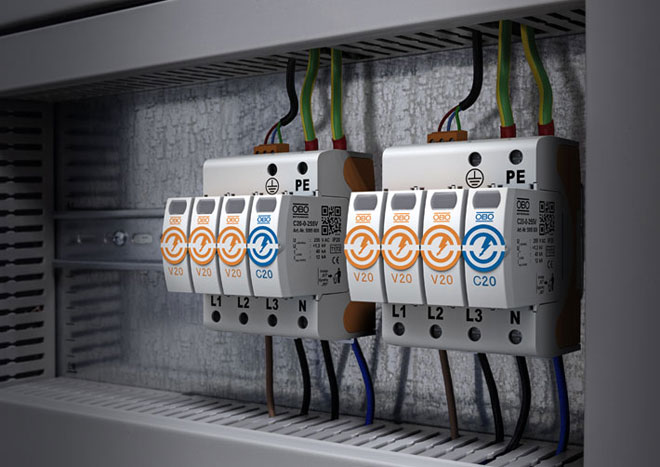
An overvoltage arrester is also characterized by a high resistance. It differs from a switching device only in that the decrease in resistance is gradual. The surge arrester is based on the varistor used in its construction. The resistance of the varistor is in a non-linear relationship to the voltage applied to it. A sudden increase in voltage also causes a sudden increase in current flowing directly through the varistor. the varistor and thus The electrical impulses are smoothed out, after which the line voltage limiter returns to its original state.
Combination surge protectors
Combination surge protectors combine both surge arresters and varistors, and can function as both a surge arrester and a suppressor.
Classes of surge protectors
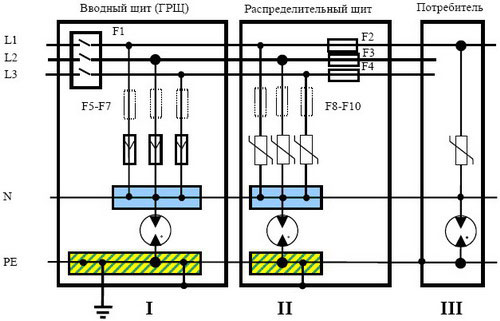
There are only three classes of devices according to their degree of protection:
- Class I device (overvoltage category IV) - protects the system from direct lightning strikes, and is installed in the main switchboard or in the input and output switchgear (IED). It is mandatory to use this device if the building is located in an open area and surrounded by many tall trees, which increases the risk of lightning exposure.
- Class II device (overvoltage category III) - used as a supplement to a Class I device to protect the network from switching effects, i.e. from internal network overvoltages. It is installed in the switchboard.
- Class III device (overvoltage category II) - used to protect against residual atmospheric and switching overvoltages, as well as to eliminate high-frequency interference passed through the device of class II. Installation is carried out both in conventional sockets or junction boxes, as well as in the electrical appliances themselves, which need to be secured.
Classification according to the degree of current discharge:
- Class B - air or gas discharges with a discharge current of 45 to 60 kA. They are installed at the entrance to the building in the main switchboard or in the input-distributing device.
- Class C - Varistor modules with discharge currents of about 40 kA. They are installed in additional panels.
- Class C and D are used in tandem when underground cable entry is required.
IMPORTANT! Distance between SPDs must be at least 10 meters along the length of the wiring.
How to choose a surge protector?
The first thing to do when choosing a surge protector is to determine the grounding system used in the building.
The grounding system is of three types:
- TN-S with one phase;
- TN-S with three phases;
- TN-C or TN-C-S with three phases.
It is equally important to pay attention to the temperature tolerance when purchasing a unit. Most surge protectors are designed to operate in temperatures down to -25. If your region has a very cold climate, and winters can be harsh, then the starter panel should not be outdoors, otherwise the device will fail.
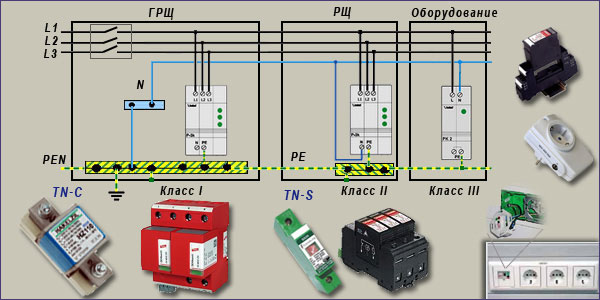
When selecting a surge protector, the following factors must also be considered:
- The importance of the equipment to be protected;
- The risk of exposure to the object: terrain (city or suburb, flat open terrain), an area of special risk (trees, mountains, water), the zone of special effects (lightning line less than 50 meters from the building, which is a hazard).
Due to the situation in which the need to install an SPD has arisen, the appropriate class is chosen (I, II, III).
It is also important to consider the withstanding voltage of the device. For devices of class I, this figure does not exceed 4 kV. Class II device withstands voltage levels up to 2.5 kV and Class III up to 1.5 kV.
Another important parameter when selecting a surge protector is the maximum continuous operating voltage - the effective value of AC or DC current which is permanently applied to the surge protector. This parameter must be equal to the rated voltage in the network. Details can be found in IEC standard 61643-1, Appendix 1.
When connecting a surge protector to protect equipment, it is important to consider the rated DC or AC current that can be supplied to the load.
How to connect a surge protector in a private home?
The installation of the SPD is made depending on the voltage rating: 220V (one phase) and 380V (three phases).
Connection scheme can be aimed at continuity or safety, you need to determine the priorities. In the first case, the lightning protection may temporarily shut down in order to prevent an interruption in the supply to consumers. In the second case, the lightning protection system must not be disconnected, even for a few seconds, but it is possible to completely disconnect the supply.
Wiring diagram in a single-phase TN-S earthing system
When using a single-phase TN-S network, the phase, neutral operating and neutral protection conductors must be connected to the SPD. The phase and zero are first connected to the corresponding terminals and then looped to the equipment line. The PE conductor is connected to the protective conductor. The surge protector is installed immediately after the input circuit breaker. To facilitate the connection process, all contacts on the device are marked, so there should not be any difficulties.
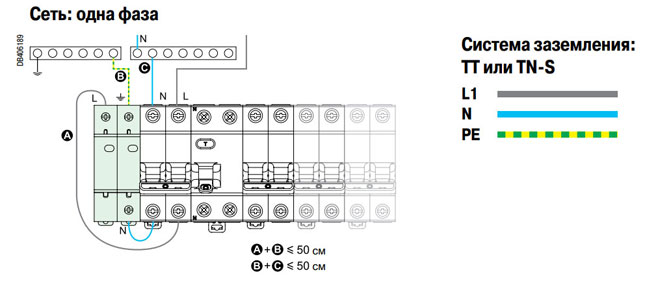
Explanation of the diagram: A, B, C - phases of the electrical network, N - working neutral conductor, PE - protective neutral conductor.
TIP. It is recommended to use fuses for additional protection of SPD, which are placed directly on the device itself.
Wiring diagram in a three-phase network of the TN-S grounding system
The TN-S three-phase network differs from a single-phase network in that there are five conductors, three phases, a working neutral conductor and a protective neutral conductor, coming from the power supply. Three phases and the neutral conductor are connected to the terminals. The fifth protective conductor is connected to the body of the appliance and the ground, that is, it serves as a kind of jumper.
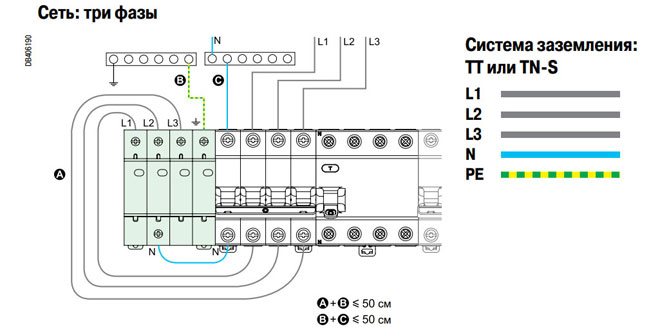
Wiring diagram for the TN-C three-phase system
In TN-C grounding connection system, the protective conductor and the protective conductor are combined into one conductor (PEN), which is the main difference from TN-S grounding.
The TN-C system is simpler and already quite obsolete, and is common in older housing stock. According to modern standards, the TN-C-S grounding system is used, in which the neutral work and neutral protection conductors are separately located.
Switching to a newer system is necessary in order to avoid electric shock to service personnel, and situations with the occurrence of fire. And, of course, the TN-C-S system has better protection against sudden overvoltages.
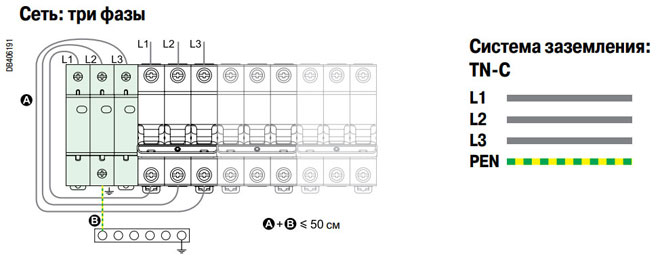
With all three variants, surge currents are routed to earth via a grounding cable or a common protective conductor, preventing the pulse from damaging the entire line and equipment.
Wiring Errors.
1. Installing a surge protector in an electrical room with a poor ground loop.
If you make such a mistake, you can lose not only all the appliances, but also the panel itself at the first lightning strike, as from the protection with a bad ground loop will not be of any use, and therefore no protection.
2. The wrong surge protector, which is not suitable for the grounding system used.
Before buying a device, be sure to find out what kind of grounding system is used in your home, and when purchasing a device, read the technical documentation carefully to avoid mistakes.
Using the wrong type of surge protector.
As we've already dealt with above, there are 3 classes of surge protectors. Each class corresponds to a specific panel, and must be installed according to rules and regulations.
4. Install only one class of surge protector.
It is often not enough to install one class of surge protector for reliable protection.
5. Class and destination are mixed up.
It also happens that class B devices are installed in the switchboard of the apartment, class C devices in the switchboard of the building, and class D devices in front of the electronic equipment.
SPD, of course, is a good and necessary thing, but its use in the power supply of the house is not mandatory. In the case of connecting this device, it is worth remembering that it is selected individually for each grounding system. For this reason, it is recommended to use the services of an experienced electrician just before the purchase, in order to avoid trouble.
Related articles:
